#AkashicRecordsGaming
Text
Alola, A-L-O-L-A Alola - Pokemon Sun & Moon

Well, it’s been long enough since SM came out that we should have all got our kneejerk reactions out of the way, and it’s been long enough that I’ve cleaned it out once and I’m starting it again (Shameimaru has too), so buckle up cause I’m gonna say some bad things about the sacred cow. Yep, that means spoilers too.
I don’t normally start with Narrative but good lord the pacing in this game is absolute garbage. It has probably the slowest start of any Pokemon game so far - the entire first island (of four) is just mind-numbingly slow and boring, with most of the game mechanics unavailable, and while being on rails early on isn’t unusual for a Pokemon game, it feels incredibly blatant in SM, to the point of being obnoxious due to the presentation. As the game continues, it looks like we’re going to reach a high point when a Nihilego busts into the Aether Facility, but then it just... continues being totally tepid. Then it looks like you’re going to reach another high point where Lusamine goes completely bonkers and fuses with the Mega Beast, except then you don’t actually fight her - you battle her exactly like you would a trainer, despite the fact that she’s just turned into pokemoncthulhu.
In general, SM’s plot feels pretty thin on the ground and schizophrenic. The world-building is really stellar, but there’s no sense of pressure, unlike the previous two games - there’s no big effects on the weather threatening to wipe everyone out, the villains haven’t managed to steal a march on you and build a doomsday laser or anything like that. In theory, you even go into fight Lusamine because you’re on a rescue mission.
On the positive side, the island challenge idea is a lot more interesting than gyms usually are (in part because the premise of a gym - that is, you’re dojo hunting, a practice that hearkens to Japanese jidaigeki and martial arts films, although it allegedly has its roots in real life - has become diluted over time), and they do a much better job than usual worldbuilding. Unlike previous regions, Alola really seems like a place where people live and have lives, rather than being a series of hubs to train your Pokemon in.
A spot I think might be an issue of real contention are Team Skull. On the one hand, they’re hilarious; on the other hand, while villain teams have always been pretty goofy (except arguably Team Rocket who are pretty worrying since they’re a legit mafia and sometimes undertake straight-up terrorist action), Team Skull are really hard to care about, which becomes a problem when the game sometimes expects you to drop what you’re doing and put them in their place, since the tone is pretty wobbly.
Overall, while SM deserves praise for actually mixing up the formula in a main-series game (which hasn’t been done before - all experimentations on the formula were relegated to side games), it’s obviously been a shaky process for them, and SM’s tone and pacing are wildly schizophrenic, which isn’t improved in the post-game (unlike ORAS’ amazing Delta Episode).
For Narrative, I give SM a 3 out of 5: it has a fantastic concept which is hampered by a schizophrenic execution, but the attention to detail elsewhere is spectacular.
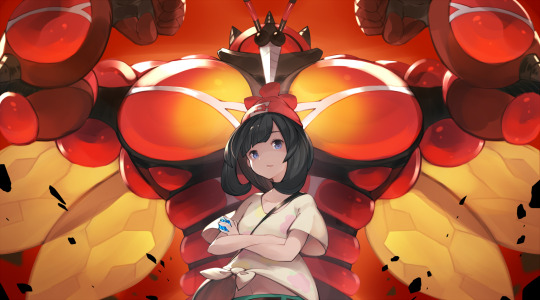
I could talk about the Audio but being real here, I’d basically just be sharing my opinion of the soundtrack, without any real objective basis near or far. If you’re interested, that opinion is that it isn’t as good as XY or ORAS’ soundtracks, but it’s still a Pokemon soundtrack so it has great tunes and the audio quality is just fine.
Instead, let’s talk about the Technical side of things. Although the game essentially runs on the same engine as XY and ORAS, they’ve changed up the UI a bit, putting moves on the right and letting you see known type effectiveness against the target at a glance. You can also now check your move details straight from the combat menu, and tapping Y twice auto-applies your last-used item, which is great when you’re on a catching spree.
On the other hand, let’s not even freaking talk about the PSS replacement. Well, we will talk about it because otherwise there’s no point in having this site but jeez. You’re now only online when engaged in Festival Plaza (and then you have to go through a double-prompt to actually get online). Want to interact with a friend? You need them to also be on Festival Plaza, and online, at the same time as you, then refresh your guestlist until they turn up, then make them a VIP to guarantee you’ll be able to interact with them at all. Yes, you can make this easier by disabling other aspects of the system, but then you’re disabling other aspects of the system to get it to do something that should be simple, and overall it’s a huge step back from the XY/ORAS PSS system. Forget about pickup trading/battles - they’re gone.
I’m also going to have to dock the game for being really laggy when it wants to be. Apparently this isn’t a problem on the New 3DS but it was a big one whenever the effects got a bit interesting; my 2DS chugged like an autistic fratboy.
All things being equal, I’ll give SM a 3 for the Technical: it took some steps forward, and some steps back, and came out about average.
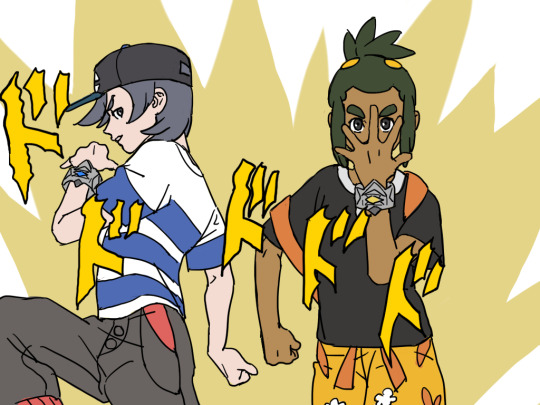
Let’s talk about the elephant in the Gameplay room first: I like Z-Moves. They’re a lot of fun, they add some surprise swing/comeback potential, and they generally don’t feel as incredibly powerful as Mega Evolutions in the previous two games have been. The little dances are also great, particularly since several of them incorporate actual hula choreography.
In terms of challenge, this game manages to be more challenging than ORAS or XY, largely because of Totem Pokemon: when they come in, their own take on Z-Power activates, giving them stat buffs, which helps to avoid the traditional problem with creating a challenge in a a boss fight in Pokemon; setting up has a big opportunity cost, in which time (because the AI doesn’t normally switch) the player can just swap to something more useful for hosing whatever the boss is trying to do. On top of that, several of the Totem bosses are dangerous picks to begin with: Totem Wishiwashi’s Schooling gives it incredible stats even before its Z-Power kicks in, Totem Mimikyu gets a free turn to do whatever it wants thanks to its unique ability... and then there’s Lusamine’s Clefable in her Cthulhu-Lusamine form, who is probably the hardest Pokemon in the game to get past. It’s not very threatening - it’s limited to Metronome (Shameimaru assures me it has Cosmic Power and STAB Moonblast but it used neither against me) - but even with a big level advantage and possibly a type advantage, it’s an incredible wall.
There’s also a sort-of-new gimmick regarding how most Ace Trainers now work: they won’t even look at you if you haven’t beaten everyone else on their route, but their fights all involve a clever tactic or a showcase of a game mechanic that wouldn’t be out of place in the competitive scene. The very first Ace Trainer, for example, runs a suicide lead with Stealth Rock and a Red Card to force you to start switching and taking entry damage, and it gets more interesting from there.
Unfortunately, the game does tend to fall into the same rut most Pokemon games do, but let’s be honest: if you’re old enough to be reading this site of your own volition you probably knew what you were getting into when you bought the game. It also revamps some older concepts, such as replacing the widely-disliked HM system with Ride Pokemon, which isn’t perfect, but it’s definitely a big step in the right direction. It’s a shame the Ride outfit looks so dorky though.
Oh, and I had a weird glitch when I fought Kukui: he broke all the rules and used two Z-Moves in succession, but that might be because my ailing 2DS was in sleep mode for like 18 hours between rounds, so I’m not weighting it as a Big Huge Bug.
For Gameplay, I’d rate it a 4: it’s definitely moving in the right direction and is a step up from previous Pokemon main-series games, but it’s still weighted down by a few flaws here and there.

Overall, SM represents a pretty bold new step for Pokemon, with an attempt for a main-series game to put its narrative front and center. That said, it’s clear that there’s a long way to go in terms of presentation and execution if they want to continue the trend in a fashion that will satisfy both brand-new players and franchise veterans.
And the awesome JoJoMon pictures is from this guy’s tumblr..
#pokemon#pokemon sm#pokemon sun and moon#AkashicRecordsGaming#gaming#game journalism#review#game review#yatagarasu
0 notes
Text
I finally did it!
The first step is officially taken, and my wings are finally spread. It just feels great to finally do this... I’m officially an amateur journalist.
It’s honestly been years since I really tried to do anything important, and I know some other people have similar experiences, spinning their wheels and unsure what to try. Just in case you’re like me, and reading this... just find something. There’s at least one thing you like, and at least one thing you can do with that online, even if you’re shy, or worried - nobody will know unless you let them.
It just requires you to act on it. I finally did, and I love it.
0 notes
Text
First Look: Pokemon Sun/Moon
I, Yatagarasu, picked up Pokemon Sun on preorder because it’s a fraction of the price buying it on release would be, and as it turns out in dropped in Australia about 30 minutes ago. Shamameiru is getting Moon on Friday, and since she does the handheld reviews I’ll leave the actual review of SM to her.
If you know anything about SM then you probably know that there was a big leak because the eShop let you predownload the game which means that some resourceful people cracked it wide open. If you avoided that because of spoilers, this is the article for you.
Also, I’m literally writing this as I play, so this is more of a ramble of first impressions and stuff, rather than my usual hyper-critical articles.
Surprisingly, the game’s opening is far from traditional - after the usual thing where you pick a name and a face (finally, we don’t get asked if you’re a boy or a girl, it just asks you which passport photo is yours), you get a cinematic of a girl running away from a bunch of thugs in white before her pokemon bag glows with an awesome power and she gets thrown into the sun. I’m going to guess that this scene is set at night in Pokemon Moon since it overlayed the logo on the in-game sun for me. And then, three months later, the game kicks off...
You can tell they’ve become a lot more comfortable working in 3D since XY and ORAS; the motion cutscenes are significantly more fluid and look less out-of-place, not least because the characters are less SD on the out-of-battle map.
This is a small thing, but after the protagonist’s mother in XY was a retired and legendary Pokemon Trainer (albeit, for racing on a Rhyhorn), I’m kind of disappointed that Alola-Mum is totally flat - Grace didn’t have a lot of characterization, but some is better than none.
As a tiny mixup, SCIENCE IS AMAZING Guy has lost weight and is on Route 1 instead of in the first town. Maybe he sweated it out under the Alolan sun?
Something that I really like is that you immediately go off the beaten path (according to what Professor Kukui wants you to do) and end up following after the mysterious waif, whose glitterpuff of a Pokemon gets bodied by Spearows like he’s Ash Ketchum or something. And then, rather than the usual happening, you defend her glitterpuff with your own body, fall off a bridge, and get rescued by... something that looks like an electric power ranger, which proceeds to shoot off into the sky. Awesome first five minutes. (Apparently it’s called “Tapu Koko”.)
Apparently, mysterious waif girl is Kukui’s assistant, Lillie. You also finally get to meet the kahuna, Hala, who is the equivalent of a Gym Leader for Alola - although Kukui’s opening dialogue implies that Gym Leaders are stronger. You also get your Starter from the kahuna, rather than Professor Kukui, which is quite a shakeup. Normally, I pick Grass types, but I saw a hilarious webcomic which prompted me to pick Litten this time, the Fire type, because I’m a horrible person. Also, Litten looks perpetually pissed off, which is just how a cat should be. To keep with the theme of recent games of bonds between Trainers and Pokemon, you don’t just get handed your starter and it becomes your loyal slave - in-universe, if it doesn’t take a shine to you, you don’t get it (obviously, the one you choose does, but still, it’s a nice touch).
Oh, and I named my Litten ‘Lion-O’ because I’m a terrible person. Lion-O comes at Level 5, with 20 HP and stats balanced towards speed and offense: 12 SpAtk, Atk, and Spd; 10 SpDef, and 8 Def. Its nature is Mild. It comes with Scratch, Ember, and Growl, and as expected of a starter type Fire Pokemon, its ability is Blaze. According to the Pokedex: While grooming itself, it builds up fur inside its stomach. It sets the fur alight and spews fiery attacks, which change based on how it coughs. Metal.
There’s a sort of new feature in the menu, “Pokemon Refresh”, which is sort of similar to the Pokemon Amie from XY and ORAS - in that you can feed them, raise their affection, and pet them - but apparently you can also groom them to clean dirt and crud off them after battle, which can apparently also cure conditions like poison and paralysis.
After picking up your starter, as is tradition, you meet and battle (one of?) your rival(s?), Hau, who has the starter weak to yours. I have to say that the battle theme against him is cute, but I like the XY one better. If you haven’t played the demo, the UI for SM is really cute; it uses a lot of bright colors and cartoony effects. I don’t actually really like how they changed up the battle menu from XY/ORAS, but it does do one cute thing - once you’ve determined type effectiveness on a Pokemon, it shows you on each move in your list whether it will be effective/super effective/not effective/nullified, which saves a lot of holding stuff in your brain. You can also check move info now by pressing L+A instead of having to go into the Pokemon menu and click through to its moves if you want to check details. Plus, you can get into your Pokeball menu just by hitting Y.
After the battle, the kahuna takes the stone you got after Tapu Koko bailed you out... he says he’ll give it back but I have a bad feeling.
Incidentally, the gesture that your mother makes when she’s up in the morning which is probably supposed to be stretching looks an awful lot like she’s decided to PRAISE THE SUN, which I suppose is fitting.
Rather than making you buy your own crap to start, Kukui outfits with you with 10 Pokeballs and 5 Potions and tells you to get to Iki Town for a festival, wild Pokemon be damned. I pick up a Pikipek (the new Pidgey) and a Caterpie (!) on the way, and get into the required fight with Youngster Jimmy, who informs me of the eyes-meet-pokemon-battle rule. He pitches a Rattata, too, which I quickly dispatch with Ember and Scratch in case it’s in the top percentage of Rattata.
Speaking of which, Alolan Rattata looks absolutely terrifying. It looks like a New York rat. “Hi, howya doin, howya doin!” *pssht* ““What the - oh, Raid? HAAAHAHAHAHAHA. I eat pussy. LITERALLY. BRING IT ON!”
Something I quite like is that now trainers don’t walk all the way over to you - they call out to you and have the battle from there, which makes more sense (since there’s obviously room between you for your Pokemon). I’m slightly less fond of the new battle animations - they’re a bit slow and floaty for my taste - but that’s hardly deal-breaking.
Speaking of rat things, the short kid with the dumb hat up the route has a level 4 Yungoos (amungoos) who is surprisingly tough and nearly killed Lion-O, who learned Lick at level 8, which is an odd choice but I won’t complain. I picked up a Ledyba, too, which I never expected to see again.
As it turns out, the festival that Kukui dragged you out to is actually a ritual battle held in honour of Tapu Koko, so you get rematched against Hau (who has acquired a Pichu). His Rowlet (for me, since I picked Litten) has been elevated to level 7, too, not that that helps it. Impressively, the arena for this battle actually shows the spectators watching the ritual battle.
Also, you get your sparkly stone back, now that kahuna Hala has fashioned it into a Z-Ring for you, which is for the new Z-Moves mechanic (you know, the one where Snorlax gets up).
Amusingly, despite being a pasty-faced golden-haired master race looking type, Lillie comments on how odd it is that Tapu Koko dropped a stone for you, ‘even though you’re a stranger to this place’... considering that everyone else is pacific islander brown, I don’t think you can comment, Lillie.
Speaking of Lillie, the next day, she comes to collect you, and...
... I’m going to stop there. That was my first hour of gameplay, and I’m looking forward to many more. Maybe I’ll see you out there on the Island Challenge!
#pokemon#pokemon sun and moon#pokemon sun#akrgaming#akashicrecordsgaming#first look#spoiler free#game freak#nintendo
1 note
·
View note
Text
Yatagarasu: Life is Strange
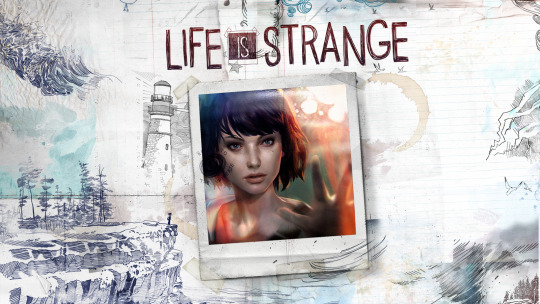
Life is Strange has been out for long enough now that you can actually talk about it without getting complaints about being spoilered, so let’s talk. Yes, that means spoilers ahead.
You don’t see a lot of adventure games that get console releases these days, unless they’re “omg so retro” 8-bit junkers that lack all the charm of 90s adventure games like King’s Quest. Bluntly, I’m surprised that Square Enix published Life is Strange on console at all, given the frosty reception Lightning Returns got (since LR is also, essentially, an adventure game).
Anyway, the premise of Life is Strange is that after a bizarre vision of a huge tornado obliterating her town, protagonist “Super” Max Caulfield witnesses a girl being shot in the school bathroom and discovers she has the ability to rewind time. After using that to save the girl - who turns out to be her long-lost best friend, Chloe Price - the two set out to uncover what happened to Chloe’s disappeared girlfriend, Rachel Amber.
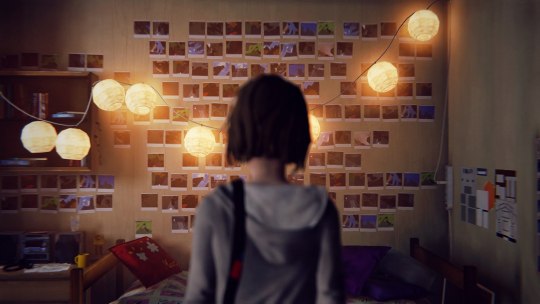
Honestly, there’s not a lot to talk about on the Technical side of things, which isn’t bad, either; the game runs at a reasonably fluid pace, it has a useful HUD that highlights objects without being too intrusive, and I didn’t notice any lag issues while playing the game.
That’s not to say that it’s totally bug-free, unfortunately. Sometimes the game slightly bugs out and forgets to have characters move their mouths when talking (Max was usually the offender for me), and occasionally, if the camera angle in a cut-scene is just right, the game will deload the sky, creating a white flash effect. I was playing this on PS4, so I don’t know if it happens on PC, although PC had its own nasty glitch where some graphics cards don’t handle the focus-on-the-photo minigame properly, forcing you to solve the puzzle by sound only (good luck with that).
There’s also another issue where during the stealth sequences, because of the loss of control over how you rewind (you can’t rewind only a second at a time, for example; Max goes back as far as Max pleases), you can get caught in an infinite loop of getting caught. That didn’t happen to me, but it can happen, and at that point your only choice is to reload the checkpoint.
There’s also a cute touch at the end of each chapter: the game will tell you what percentage of players worldwide, and what percentage of players on your friends list, did for each choice.
That being said, the technical in this game gets a 4: it’s above-average, with few bugs; what bugs it does have are either hardware-related or have little impact on gameplay, and can be fought through without much difficulty.
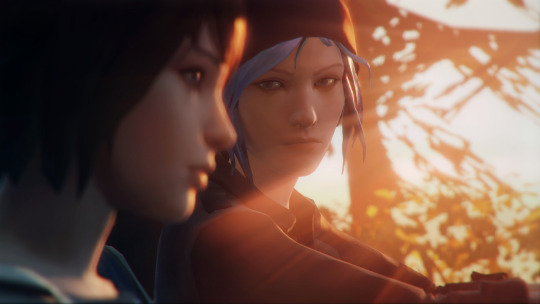
On the Gameplay side of things, well, one of the problems with an adventure game is that the amount of actual gameplay is relatively limited in a cool-paced game like this one - you aren’t going to get obliterated if you don’t turn into a mongoose in the next three seconds, for example.
Max’s time-rewind power is actually a pretty interesting take on the concept. When Max rewinds time, she herself is immune to it, including things she has on her person. This means that she can take something right in front of someone (like their keys, for example) and then rewind so that she never took it - she just has them now, breaking cause and effect. This can also be used to functionally teleport - for example, getting inside a locked room after blowing the lock and tripping the alarm, then rewinding and unlocking it from the inside. In one puzzle later, you pull a heavy object down from a ledge so that you can climb up on it, and then rewind it back onto the ledge to use it as a counterweight.
Unfortunately, I feel like this goes relatively unexplored by the game, as it only gets used in a few specific places rather than being a more-common problem-solving method, so I think it’s rather under-used. Also, while Max can normally break cause and effect for any item she’s holding when rewinding, there’s a couple of spots during the game where that doesn’t work, just because, which is pretty poor.
Overall, I’d give the Gameplay a 3. Being blunt, it’s an adventure game, and not one with a combat system; there’s periodic problem-solving and stealth sequences, but most of the game consists of walking and clicking.
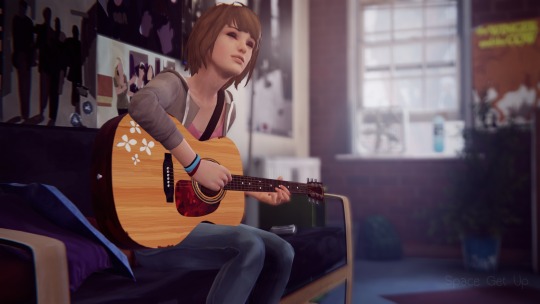
On the AV side of things, I’m kind of on the fence with this one. The game certainly has its own art style and it sticks to it - it’s kind of like a water-color painting - but on the other hand, the models can sometimes be a bit uncanny, especially hair, which looks like playdough.
Generally speaking, this game isn’t big on the music unless it’s diegetic, although most episodes of the game have a montage set to country guitar, which I don’t mind, but occasionally it can lay it on a bit thick. That said, the pieces are well chosen and fit the style of the game.
Also, the voice-acting is pretty spot-on in this game, tiny budget aside (most of the minor cast are also voiced by the major cast). The game drew some flak for its outdated and kind of bizarre slang, but since our protagonists are a loser hipster and an angry faux-punk throwback, it’s fairly fitting (and has actually started seeing some use among fans of the game, not always ironically either).
The AV gets a 4 here. While it’s sometimes a little uncanny, the game sets forth its style and absolutely sticks to it rather than just trying to be photorealistic “good”, and when music is used it fits well with the game.

And now the Narrative, which is kind of the point of an adventure game. Generally, the game is pretty decent about this, and when Max is being stupid for the sake of the narrative it doesn’t really hurt your sense of control because it’s made very clear that Max is her own character.
Before we move on, I’d like to talk about something this game does very well, which is that almost every character has duality to them. Pretty much everyone you like on sight has a dark side, and everyone you dislike on sight has a light side - just like real life, in other words. The game is very good at using this duality in conjunction with choices-of-consequence, major and minor, so that your choices pile up on each other and can change events quite dramatically.
The main theme in the game is the butterfly effect, expressed through the title Philip Merilees created for Edward Lorenz’ 1972 presentation to the AAAS: Does the flap of a butterfly’s wings in Brazil set off a tornado in Texas? In this case, the tornado is quite literal, and the game is rife with butterfly symbolism: a blue butterfly appears immediately before Max gains her powers; in the last act, Max wears a shirt with a death’s head moth on it (close enough); when she creates graffiti in an alternate timeline, she scribbles a butterfly.
As it turns out, the tornado (and the double-moon, and the whales beaching themselves, and the fish drying up, and the birds comitting sucide, and the eclipse...) are due to Max’s first use of her powers, to save Chloe - in effect, the tornado is the Gargoyles from the Doctor Who episode Father’s Day; there is a wound in time and the tornado wlil sterilize it.
Unfortunately, this ends up leading to a Bioware Choice that renders the rest of the game largely irrelevant. Summed up in the semi-memetic phrase “bae or bay?”, your choice is simple: go back in time and allow Chloe to die, preventing armageddon, or choose Chloe and put Arcadia Bay under. (At the time of this writing, 53% of players worldwide chose bay over bae.) Chloe gives a big speech about how since Max will remember the old timeline everything that happened was real, but it feels like a cop-out to make the players more accepting of the shaggy dog story they’ve been playing a part of.
On the other hand, the game also ends with a sequel hook wide open: throughout the game, you hear much discussion about the Prescott family’s ‘destiny’, which never comes to fruition; Max’s blue butterfly appears on Chloe’s coffin if you chose bay; and the thank-you-for-playing specifically refers to these five episodes as Season One. There’s even a digital TV miniseries in the works. Considering that DONTNOD was totally out of money by the time episode 5 hit production, it definitely gives the impression that if possible, they’d like to do a season two.
At the end of the day, I’m going to give the Narrative a 4. Uncovering the mystery, and the duality in each character, is a lot of fun, but by the same token, the ending does a lot of damage to the plot as a whole, and many aspects of the game are very unexplored.
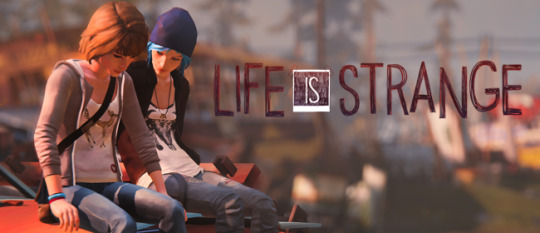
In terms of Fun factor, honestly, there’s not a lot to be said. If you like walking, clicking, and talking, then you’ll find this game fun. If you don’t, you won’t. I’m not even going to bother to give it a numerical rating because, in my opinion, the fun factor in this game is really that binary.
You can pick up the whole thing for like twenty bucks now, and the first episode is totally free, so you should at least check that out. I’ve spoiled the ending, but honestly, everything between the beginning and the ending is what makes the game worthwhile, and I strongly recommend it.
Oh, and there’s a yuri genre fan remake, Love is Strange, that you can grab here.
#yatagarasu#AkashicRecordsGaming#akrgaming#life is strange#game journalism#review#game review#spoilers
1 note
·
View note
Text
Crap From Japan: Digimon Story Cyber Sleuth
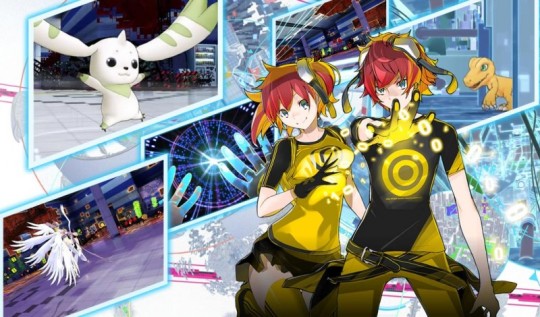
I, Yatagarasu, missed a regularly-scheduled update thanks to it being the business end of the school year, so here’s the inaugural edition of a semi-regular feature I plan to do. Basically, I play a fair chunk of Japanese games, including import titles or stuff that only got released in the west by fluke, so periodically I’ll give you a Crap From Japan column about what I’m doing.
Cyber Sleuth literally only got released outside of Japan because of a fan petition, which is about the only time a fan petition has ever actually worked. I guess when you have 65k+ people saying “we’ll buy this if you release it here” you have some pretty good data on your cost-risk-reward analyses.
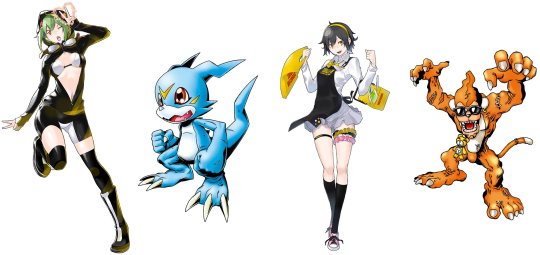
Let’s begin with the Technical aspects. I’ve been playing this on PS4, and the Vitaness shows; the control scheme is fluid but doesn’t take advantage of the PS4′s controller. Thus far, I haven’t noticed any actual bugs, except in the translation, which is... a problem. They definitely didn’t put their A-Team on the translation with this one, and it varies heavily between “extremely polished” and “DUWANG”. Notably, after a given point, the characters begin referring to Eaters as “Bakemon”, when the word being used is actually bakemono (monster). Using the DigiLine, a method of interacting with your Digimon, is often hindered because the correct answers might be swapped around (haddock and mackeral are the prime example, where you can respond “A haddock!” and get the response “Nope, the answer is haddock!”), and it can be very difficult to pick up pointers on where to go next because the translation has used the wrong word (”Shinjuku” and “Shibuya” get mixed up more than once).
On top of that, the translation, even when it’s polished, makes some... interesting choices in how to handle some choices. As with most RPGs, you often get choices that lead to the same result. In Cyber Sleuth, the feeling of a loss of control is somewhat limited because Aiba (that’s the protagonist) is very much their own character, not just a cut-out for the player. The translation, however, sometimes does this weird thing where instead of three distinct choices of how to say something, it gives one block of text and lets you choose between lines, which is just weird. Also, for some reason the translation uses male pronouns no matter which sex protagonist you chose, except for rare instances of gender neutrality and one odd instance where you’re referred to as female even if you’re the male protagonist.
Interestingly, the game mistanslates the “junkyard” of the internet as “Kowloon” when it should be “Cool-Wrong”, but this was intentional - it’s the same way Digimon World Dawn/Dusk translated it, so it keeps the localization consistent.
Oh, and the waifu on the right up there is from a real-life brand (actually, tons of stuff in the game is), which is a problem since they couldn’t include it in the localization due to rights. This one kind of plagues the game over and over, but they didn’t change a lot of the graphics so if you can read Japanese you’ll have an advantage when it points you you to some bland-name place.
Overall, I give Cyber Sleuth a Technical rating of 3: while the game is largely bug-free as such, the translation can often impact on your ability to play the game, and is frequently chunky at best.

Moving on to Gameplay, this game is essentially divided into three parts: doing your detective thing from Point A to Point B, combat, and Digimon raising. The first two are relatively simple (maps are small because Vita, reducing the headache of running from place to place), and while combat animations leave a bit to be desired, the combat is actually relatively deep without being overly complex, with a three-layered elemental effectiveness system (taking into account the attacking and defending Digimon’s attributes, their elemental type, and the elemental type of the attack they’re using). Where the game gets arcane is when it comes to raising Digimon using the Farm.
The base requirement for a Digimon to evolve is a level requirement. From there, most evolutions also have stat requirements, including also a minimum Ability score (increased by evolving and de-evolving a Digimon repeatedly) and CAM score (Camaderie; increased by actively fighting with that Digimon). Most high-tier Digimon require high Ability scores (80 or more), while Digimon that were partners of the anime characters need a decent CAM score, and if you want to perform a DNA Evolution, then both Digimon involved need 100 CAM. Some Digimon also have further requirements (such as the pre-order/PAL Bonus Black variants of the Agumon and Gabumon lines, or Digimon unlocked through sidequests or DLC quests).
By using the Farm, it’s possible to increase a Digimon’s stats in a way that remains with them when they evolve and de-evolve, like bonus stats. What the game doesn’t tell you is that there’s a cap on how many bonus stat-ups a Digimon can have (referred to as their SKL, which is hidden from you), and this can easily lock you out of being able to get a Digimon you’ve been raising towards.
On the other hand, you don’t need to do anything complicated to proceed in the game, and by the time you really care about tweaking perfect stats and raising the perfect partner, you have access to items and opportunity to do so, which means that the mistakes you make while learning the system have no real long-term impact.
I give Cyber Sleuth’s Gameplay a 4: it’s solid, not overly arcane, and you can obliterate the game if you learn how it works, but it can also be a bit unengaging and often very little is actually directly explained to you.
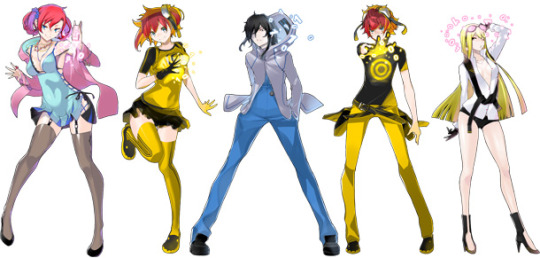
On the Audio-Visual side of things, the character design in this game in this game is totally spectacular, with the humans drawn by Suzuhito “Anti-Gravity Tits” Yasuda and the creature design by Oh!Great. Unfortunately, the character models are relatively low-detail, although because they seem to have been designed that way from the ground up, it doesn’t look bad like it might have - it’s clear that they knew they were going to be running this on a handheld and began making models with that in mind, rather than creating HD models and then scaling back.
Digimon isn’t exactly a stranger to fanservice, but Yasuda’s artwork also makes it clear who the target audience is. With Digimon Adventure landing in 1998, the people who watched it as kids are adults now, and Cyber Sleuth is targeted at that market in particular. One of my friends who picked this up prefaced her opinion of it with “ugh all the women in this game are too fucking hot”, which should give you an idea.
As for what Oh!Great had to do with it...
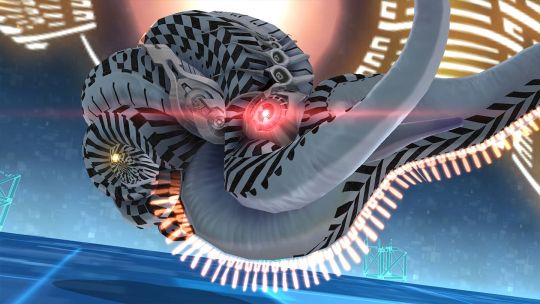
Jesus Christ.
The CGI cutscenes are done by Kamikaze Douga, who were also responsible for Fire Emblem Awakening and the openings for JoJo’s Bizarre Adventure, so they look pretty spectacular most of the time. The biggest letdown is the music, which is just strange since it’s done by Masafumi Takada, who gave us some great soundtracks in the form of the upbeat electro-techno of Vanquish and the audible schizophrenia of Dangan Ronpa. Overall, the audio just plain lacks charm and any real stand-out tracks, and most of the real-world areas lack any music at all, which is kind of annoying when you’re running around and don’t even have anything to hum to.
Also, I never thought I’d say this about a game starring Chika Sakamoto, Norio Wakamoto, and Maaya Sakamoto, but the voice-acting is overall pretty sub-par.
I have to give the Audio-Visual a 2 here. If 3 is average, this game is pretty below-average when you’re actually playing it; it has stand-out moments, but overall, it’s not great.
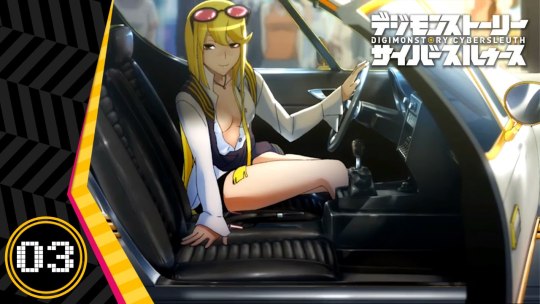
Remember when I said this game was aimed at adults? The Narrative drives it home. This is a Shin Megami Tensei game in Digimon-flavour wrapping.
Actually, the game’s setting borrows a lot from Summer Wars (with EDEN as OZ), which was itself often seen as a retool of Our War Game (the middle portion of Digimon: the Movie). It then takes about ten minutes before it goes straight into SMT territory, with net-users falling into comas due to Eaters eating their brains while they’re net-diving and the company behind it covering it up (this doesn’t count as a spoiler because if you use your brain you will work this out within the first hour of gameplay).
Unfortunately, the third quarter of the game is really slow, where the narrative just kind of chugs as you go from Royal Knight to Royal Knight (again, not a spoiler: you can download a theme with them from PSN and they were heavily promoted in the leadup to release). On top of that, the translation occasionally hinders the narrative. In particular, early in the game, when you have your first encounter with a ghost, he asks you to look for him... unfortunately, this is the literal opposite of what you’re being asked to do. He wants you to not look for him, because what he’s doing right now is extremely important.
On the other hand, some parts of the game are very well-researched. For example, Arata, your hipster supa hacka buddy, uses “Blue Box” as his online handle, which is a reference to a now-obsolete phone phreaking tool. Actually, Arata in general is pretty fantastic - when he becomes public enemy number one after taking the fall for what is perceived as a terrorist attack, he simply remarks “Excellent. Another item off my bucket list.”
I’m not sure how much of this is due to the translation screwing up, but Nokia is a bit... interesting. In the cast shot up there she’s the girl in blue on the far left and she’s obviously a knockout, although her personality is pretty obnoxious and she’s a bit of a bimbo (she gets better as the game progresses), but she’s frequently referred to as being ugly or fat. I’m of the suspicious that in the Japanese, the insults aimed at her are largely based around her self-centered personality being ugly, and that was missed by the b-grade translation.
I give the Narrative a solid 4: while it’s let down by the translation at points, reading between the lines will give you a great cyberpunk story in the vein of MegaTen, and it has tons of great references to real-world hacker culture and Digimon as a franchise.
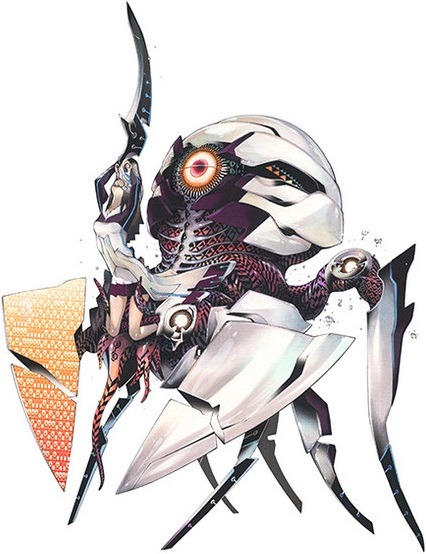
When it comes to Fun, I’m kind of on the fence about this one. On the one hand, it’s a game you can pick up and put down really easily, and you can play it either super-casually or super-hardcore in terms of Digimon raising style (there’s even at least one Western league that has online tournaments). On the other hand, the fact that this was designed for handheld really shows; the game can often be fairly unengaging and what you can end up doing is just slogging from point A to point B to get the next dose of plot.
On the other hand, it’s been nearly a year and I’m still playing the game, which means it’s doing something right. It may not press all my buttons, but it presses enough of them, and I played and enjoyed Digimon Rumble Arena 2, so my threshold is pretty low for stuff with a Digimon brand on it.
For Fun, I’ll give Cyber Sleuth a 3: I haven’t ever got TOTALLY HYPE about it, but I’ve never been super-bored with it, either; it’s solidly average.
In closing, I think this one’s pretty simple: if you like Digimon and don’t have the time for a hardcore raising game, buy this. I regret buying it at full price, I admit, but by now the price has dropped enough that you shouldn’t worry about it anymore. If you’re a parent, though - definitely don’t buy this for your under-10 kid who’s been watching Digimon Fusion; this is not a game for kids.
#yatagarasu#digimon#digimon world cyber sleuth#game journalism#AkashicRecordsGaming#review#game review
1 note
·
View note
Text
Yatagarasu: Bloodboned
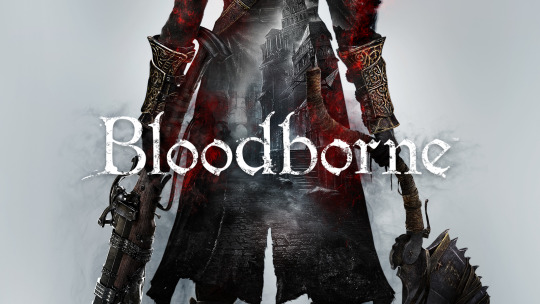
Did you ever play a game you really wanted to like and just couldn’t? Bloodborne is that game for me.
Before we go any further I should mention that I’ve flirted with Souls series games before, but most of the time I ended up putting them down for being too easy for my taste - raised on a steady diet of Devil May Cry 3 and God Hand, the slow pace of From Software’s dark fantasy outings felt like time was standing still around my character. I’m more fond of their fast-paced Armored Core games.
Bloodborne is From’s 2015 offering, and I’d mostly seen good things about it when I picked up the GOTY offering on sale for sixty bucks Australian. I’ve spent most of my time playing it onstream, although since my internet is also Australian I’m not usually very active in stream chat. Unlike the Souls series’ trademark defensive playstyle, Bloodborne allegedly tries to push you to be inclined to fight more offensively, introducing new mechanics and taking away some old ones in the process. Well, let’s start with the Technical details.
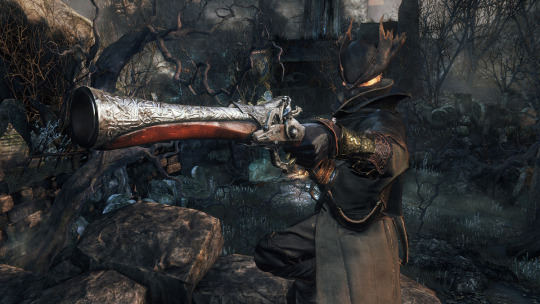
Even before the game was released, From kicked up a shitstorm by saying they would aim for 30 FPS rather than 60 because that was the best for action games. You can imagine the chilly reception this got from gamers all over. Personally, I don’t really mind either way, so long as the game works at 30 FPS or 60 FPS or whatever it’s supposed to run at. Unfortunately, Bloodborne... doesn’t. This is a game with more than its fair share of magic effects and fire going around (fire being a major theme in the game, actually, as it’s believed to purify corruption and disease), and about half of them make the game lag, and lag badly, sometimes slideshowing. It gets worse if the camera is close to the effect, which is common because From Software have yet to release a game with a decent camera and Bloodborne’s aesthetic is all about gothic victorian architecture as designed by Escher.
Even that wouldn’t be so bad if the controls weren’t extremely clumsy. When you’re playing at a slow pace they do okay, although the huge delays on some inputs can make playing the game more than a bit frustrating when enemies begin to speed up. Unfortunately, this game has a serious problem: pressing buttons quickly in sequence can cause your inputs to get crossed, so that, for example, you accidentally heal twice, or dodge a third time, and that will usually get you killed. That would be okay if you didn’t have to dramatically pick up your pace in later stages of the game.
On top of that, this game’s collision detection and hitboxing are absolutely atrocious. The first boss in the game is known to be able to throw you out of bounds with one of its attacks because it pushes you through the floor. The Chalice Dungeon version of Amygdala has a known issue where she can put herself out of bounds where you can’t hit her, and will pick you off with impunity with her laser attack. In Chalices with randomized boss rooms, facing a Blood-Starved Beast in a small room can cause it to get stuck inside a wall, which usually shuts its AI off entirely. During the first ‘shooting gallery’ portion of Old Yharnam, there’s a diseased Beast-type enemy that will almost always get stuck below the floor, able to attack you (invisibly, no less!) and very difficult to hurt back, or even see in the first place.
The awful hitboxes have been carried over from earlier Souls games, but because of the way defending yourself works in Bloodborne, the problem is a much larger one here: certain attacks become functionally unavoidable unless you predict them well in advance, and against combination attacks, if your inputs get crossed, which is very prone to happening, you’re probably going to die instantly through no fault of your own.
This game also has a serious problem with vertically-sloping terrain, which is a problem when huge stairways are a part of your aesthetic. Enemies can sometimes walk on thin air off a slope (which will cause you to be knocked down if you touch them before gravity reasserts itself, as if they’d fallen on you), and your most powerful attack, the Visceral Attack (essentially the equivalent of a Souls backstab), is almost totally dependent on the whims of the game engine: if you’re too far, too close, or at a sloped angle, it won’t come out more often than not, which has a non-trivial chance of causing you to lose the battle of attrition through no fault of your own. Lady Maria of the Astral Clocktower, one of the bosses from The Old Hunters DLC, is particularly prone to this: if you aren’t using one of a specific set of weapons to stunlock her, your best choice is to parry her and then hit her with a Visceral Attack, which would be fine, if the floor of her boss room didn’t slope lightly, causing it to just not happen most of the time (and usually causing her to combo you as she gets up, which can prove instantly fatal).
As if this somehow hasn’t enough of a problem, enemies can be extremely buggy in this game, which is of course made worse by your two defensive mechanics not working most of the time. It happens occasionally with regular enemies (the second wheelchair in the Upper Cathedral Ward pre-area is capable of firing in a 180-degree arc in front of himself, even if this means that the bullets are travelling at a 90-degree angle from the way his gun is pointing), but more damning is that it can happen a lot with bosses. My personal favorite is the Blood-Starved Beast: it has a grab attack that will reliably one-hit kill basically any character, even a massively over-levelled one, because in addition to the tremendous damage, it will also poison you whether you like it or not, and odds are you’re dead before you can get back up. This is supposed to be telegraphed by it going very still for a second or so, but for reasons that escape me, it’s possible for it to “buffer” this charge time during its recovery from other animations, or during its get-up animation after you knock it down, causing this one-hit kill attack to come out of nowhere.
I’ll talk more about this in the gameplay section, but your other defensive option - parrying with your gun - is also very prone to being worthless, which can be because the enemy is simply immune to being parried (which is a lot of enemies) or because your bullet passed clean through the enemy, which happens a lot more than it has any right to.
On the plus side, this game’s level design is actually really spectacular, with one particular problem I’ll discuss in the gameplay section. Rather than a lot of checkpoints, most “levels” have a checkpoint at the start and the end, but as you progress through the “level”, you will find more and more doors that only open from the back side, which create shortcut chains from the first checkpoint often to the last checkpoint. This style of design is rarely seen (I actually can’t name another game that does this, or at least does it well), and it really works.
I’m not going to talk much about PvP online play, or PvE for that matter; being in Australia, my internet is garbage on a good day, and I’ve yet to actually play a console game over the net that didn’t have big lag issues. The asynchronous multiplayer via leaving notes and death ghosts is carried over from Souls, which definitely isn’t a bad thing.
Finally, on launch, this game had a huge number of bugs ranging from item duplication to online play making the game unwinnable, along with extremely long load times. These have by and large been addressed through patches (they were patched before I even touched the game), but that’s the kind of thing that shouldn’t have been in a “finished” product to begin with. On top of that, the game is still riddled with bugs - more things even on top of what I’ve discussed above, such as visceral attacks failing to give back rally health or blood echoes disappearing from where you died without being picked up by an enemy - but it’s fairly unlikely at this point that the product will continue to be supported with patches. While this isn’t something I can hold against the game itself, the Souls community is notoriously unaccepting of any criticism of game bugs or sheer fake difficulty (”GIT GUD”), which means that legitimate complaints tend to get drowned out.
That being the case, my Technical rating for Bloodborne is a 2: the game has many technical issues, and they impact heavily on gameplay.
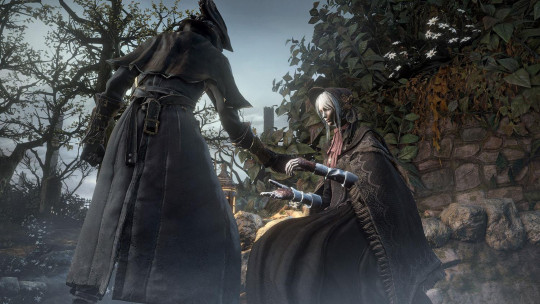
Next, we’ll move on to Gameplay. The short version is that Bloodborne has some pretty serious problems. Let’s start with your defensive options: putting aside the two shields (which are highly specialized defensive options for specific fights - requiring you to know in advance about a boss, or to have died against it in the past), you can either dodge things, or attempt to parry them, which means shooting them in the face mid-attack. Unfortunately, due to From Software’s trademark hitboxes, dodging is a coinflip on a good day, and it’s often possible for an attack to hit you from about two meters away after dodging due to how much they stick around after the attack is performed. As for parrying, against many enemies, you simply can’t parry them, and if you can, there’s a non-trivial chance that your Visceral Attack won’t work when you try it (getting you killed), or maybe you’ll get hit by them anyway and then you have to hope that the Rally mechanic actually works for you when you get up and Visceral them (if your Visceral attempt works to begin with).
On top of that, lots of bosses in this game really suffer from the fakest of fake difficulty. If you have to know about a boss in advance to counter it - either from reading up a guide or dying to them in the past - then odds are it’s not a well-designed boss. Martyr Logarius may be my favorite example: in his second form he becomes immune to bullets unless you backstab him while he’s charging up. How do you know this? You don’t, unless you read the wiki and know in advance that backstabbing Logarius while he’s charging up, despite doing no extra damage, not causing him to stagger, and putting yourself at risk of being blown up, will cause his invisible anti-bullet magnet shield to fail during the second half of the fight (oh, and sometimes it works anyway). Some other bosses cause basic gameplay mechanics to break down: the Orphan of Kos (some say Kosm), for example, jumps around a lot which can cause your camera to cease locking onto him, which will almost certainly get you dead through no fault of your own.
Later in the game, most of the enemies you fight are essentially bigger, badder versions of enemies already fought, and rather than, for example, giving them a variety of new techniques or imbuing them with a combat strategy, they simply have more health and even if you’re 40 levels above where you should be most basic enemies will begin hitting you for at least half of your health. That wouldn’t be a problem in a game like, say, Devil May Cry 3 or God Hand, where you have defensive options that genuinely are an answer to everything the game can throw at you, but your defensive options in Bloodborne simply don’t work a non-trivial amount of the time.
A problem with the game’s level design that’s more of a gameplay issue than a technical one is that the game tends to assume that you run everywhere. That’s fine, but this is a game that greatly encourages you to not fight more than one or two enemies at a time (preferably not more than one at a time), and since running is considered ‘noisy’, it’s as if you’re encouraged to walk instead, particularly given the character’s not-intolerable walking speed. Unfortunately, this causes a lot of proximity-based jump scares to fail (Chalice Dungeons in particular have this problem, where pthumerian ghouls in coffins will explode out of the coffin about a meter in front of you swinging at thin air, which is where you would be if you were running instead of walking), and almost any kind of uneven surface, including doorways, the tops of stairs, and pressure plates for traps can result in you getting stuck and walking in place if you don’t approach them at running speed.
A further problem with the game’s damage balance is that part of the justification for enemies doing such a ridiculous amount of damage (I won’t accept “just don’t get hit” when your defensive options are this poor) is a mechanic called ‘Rally’, which restores health up to a certain amount when you deal damage to an enemy for a short period of time after taking damage. Unfortunately, the amount you can heal through rally is almost never even close to the amount of damage you take (unless you get a visceral attack after trading on a parry, although the Saw Cleaver weapon comes pretty close when it wants to), and attacking will, of course, leave you open to getting attacked in return, limiting the usefulness of this mechanic.
Oh, and then there’s Frenzy. Nobody has anything good to say about Frenzy. It’s meant to emulate the Lovecraftian “go mad from the revelation” thing - the equivalent of Sanity damage in Call of Cthulhu - but instead what it actually does is fills up a special Frenzy gauge (which fills up faster based on how much you have of the game’s more-important currency, Insight), which continues to fill for a period even after you get rid of whatever is causing Frenzy, and if it tops out you take damage equal to about 80% of your maximum, not current health, as your brain literally swells with eldritch knowledge and tries to explode out of your skull. Did I mention that everything that inflicts Frenzy either also inflicts damage while doing it, or inflicts Frenzy as part of a damaging attack?
There’s also Beasthood, which is an extremely poorly-explained game mechanic (by which I mean it is not explained at all in the game itself) which can be a huge boon to a physical character - unfortunately, being able to use it properly requires beating Laurence, the First Vicar, who is one of the DLC’s harder bosses due to his extremely poor hitboxes in his second form, which can make it impossible to meaningfully damage him at all.
Finally, the FashionSouls problem (if you find it a problem) returns; after a few hours, the defensive bonuses you get from armor just stop mattering versus the amount of damage enemies do, but new gear is still treated as if it’s a reward well after that point, which is kind of eh design (if you’re going to do that then I’d rather bonuses and cosmetics were separated, like a Glamour system). They might be helpful in PvP but as discussed above my net is total garbage due to Australia so I don’t normally invade or seek invasions (although I’ve won three out of five invasions I’ve had, sadly not including the time I was invaded by John Cena on-stream).
In all, my rating for Bloodborne from a Gameplay perspective is a 2: the foundational mechanics of the game are well thought-out, but very poorly executed, and it suffers from many of the problems that detract from Souls games.

Let’s talk about the Audio-Visual side of things. Putting aside the game’s tendency to lag when it displays anything other than a texture, Bloodborne is really gorgeous, visually, with spectacular backdrops and beautiful gothic victorian landscapes. On the musical side of things, the game is unfortunately pretty lacking; most of the game has no music at all, with musical cues reserved for boss fights or the Unseen Village. On top of that, a lot of the music feels very generic and phoned in; the theme that plays when fighting the Watchdog of the Old Gods is a particularly notable example, as it is at points close to plagiarism of Koh Otani’s Liberated Guardian: Battle with the Colossus from Shadow of the Colossus, ironically making it the best track in the game.
If I have a criticism about the visuals, it’s that the amount of details on a lot of models can make it very difficult to actually see the shape of the enemy, which is particularly the case with large beast-type enemies, like Vicar Amelia (pictured above; even in the still, her muzzle is distorted by the motion blur the game uses to make up for its 30fps frame rate, although at tumblr-size it doesn’t show up well) or the Abhorrent Beast (which is exacerbated by his extremely janky hitboxes and rubber-stretch arms). Particularly when enemies are moving quickly and you’re engaged with them, it’s very easy for them to start resembling blobs of colour more than actual characters.
On the other hand, the game’s dedication to real-time decal-placement of blood spatter is absolutely phenomenal; when you come out on the other side of a gorefest, it looks like it, although the fact that blood never runs as a liquid (it’s simply placed as a static decal) is sometimes very obvious and immersion-breaking, and depending on where the decal is placed, it can look extremely bad (dark areas with fine textures on the walls in particular can get a ‘zebra stripe’ effect if they get blood on them). The Kirkhammer weapon in particular looks spectacular with blood on it, as the script engraved on the hammer is actually engraved on the model rather than being a simple texture, causing it to glisten when blood-coated.
For the AV side of things, I give Bloodborne a 3: they’re very solid and some parts of it are quite gorgeous, but the relatively poor audio and occasional video issues prevent the rating from going any higher.

In terms of Narrative, I think Bloodborne is actually pretty spectacular: the game is told through story breadcrumbs, and you’re encouraged to come up with your own interpretation of just about everything. While this isn’t a new tack for From to take, it works particularly well in Bloodborne’s Lovecraft-inspired setting, particularly since the canon of Lovecraftian works extends far beyond Lovecraft’s own writings. I think this style is particularly good in games like Bloodborne; if you’re just here for the hack and slash, you can ignore it, but if you’re a lore fiend, you can spend hours piecing together evidence and coming up with perfectly good theories.
To make a complaint about it, I’d have to go with the usual From problem: there are very few characters in the game you can genuinely interact with, which is probably a big part of why the Pale Doll is such a popular and adored character. Of course, that kind of design choice is also part of what makes the Souls series what it is.
I’m not going to spoil the narrative because that’s half the fun, but I’ll give it a 4.

Finally, let’s come to the Fun rating. I mostly talked about the fake difficulty issues in gameplay, and this isn’t honestly a game with a lot of padding (although the first half of the Nightmare of Mensis and most of Forbidden Wood comes to mind), since I’d say about 2/3 of what’s in the game is essentially optional - the actual core of the game is very short, although not doing anything optional will probably cause you to get rekt. Despite my complaints about technical and gameplay issues, this game definitely has that X-Factor to it that has me continuing to play it, although it does fall into an issue where the later stages of the game (particularly late Chalice Dungeons) can become more of a chore than a pleasure, and the fake difficulty can make the game frustrating in a way that isn’t pleasurable when you pass it, since often the reason you were successful is simply because the game didn’t screw up this time rather than working right from the start and you getting rekt because you’re bad. The Old Hunters in particular can be a real chore, especially if you’re on a NG+ (which gives all the enemies significantly more health and makes everything in the shop much more expensive).
That being said, my Fun rating for Bloodborne is a 3: it’s often more enjoyable than not and it has some star power to it that keeps me coming back, but it also can be frustrating and a total chore during portions of the game.
In closing, my opinion is that Bloodborne is worth buying, just not worth buying for sixty bucks. By now, the price has come down quite a way, or you can try and find a pre-owned copy for stuff all, and that would be my recommendation.
1 note
·
View note
Text
Release Schedule
Hello, I’m Shameimaru.
As you might be aware, we hadn’t quite gotten a solid schedule down for our reviews. This has finally changed! From now on, every Saturday, you’ll be getting a review from me, and every Wednesday, Yatagarasu will be providing you with their own, harder looks at popular games.
Additionally, I’d like to begin coverage of current or upcoming gaming releases within the extent I can perform. Without the popularity for a wide audience for pulling up every bit of news as it occurs, I’d like to stick to overviews. Because of this, I’ll be working up a post for coverage of all information we currently know about Pokemon Sun and Moon.
We here at AKR Gaming would like to thank all those interested, and hope we can gain your support as we continue onward. And remember, you’re always free to talk to me at akashic-shameimaru here on tumblr and at @Shameimaru_AKR on twitter.
0 notes
Text
Ace Attorney: Dual Destinies Review (Spoiler-Free)
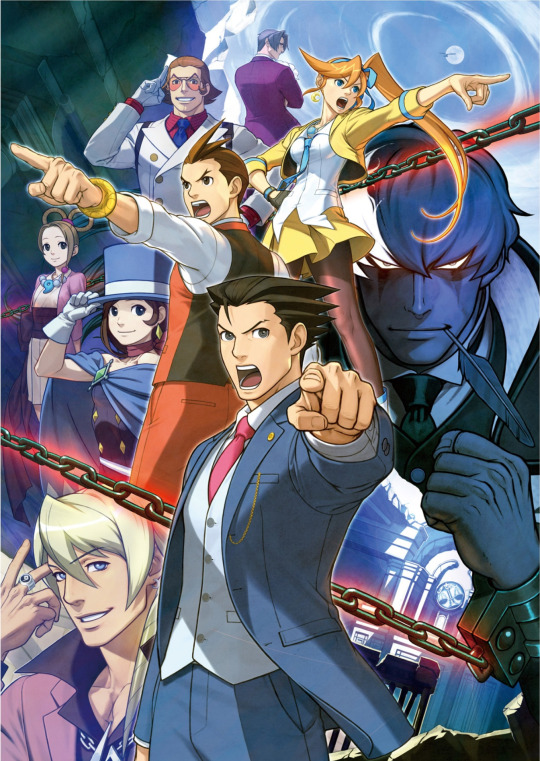
Hello, I'm Shameimaru.
I already know that to a lot of people, this game was kind of a controversy. However, I’m going into this with an open mind, and that is the first rule of reviewing a game. An open mind doesn't mean a lack of experience, however – I'm an experienced Phoenix Wright fan, and I've played every game except Apollo Justice to completion through the years, though not, unfortunately, the collection for the 3DS. With that background out of the way, I can begin, with my audience informed.
I'd like to leave this review as spoiler-free as possible, but still go into details, so I'll be discussing a lot about the first case, but in less detail, as it is much less of a spoiler than say, the third case, and primarily covering mechanics introduced, the quality of cutscenes and the like, and meaningful moments without a lot of detail in them. If you would like zero idea what the game contains, this review isn't for you, but if you want to know if getting into it is worth it without spoiling the plot for yourself, you're the target audience.
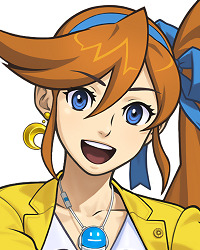
The first thing we're treated to is a cutscene, to introduce a new character to the franchise, Athena Cykes, who we’ll be playing as for this trial. The voice acting... isn't terrible, but it's definitely sub-par. I don't mind it, but I can see why, if it continues at this quality all game with a large amount of cutscenes, that people would grow to dislike it.
We're also quickly reintroduced to Apollo Justice, returning from the fourth game, which I have the least experience with. I have played it, just not to the end, so I'm not totally unfamiliar with the character. He already seems more mature in this game from the moment he shows up, but that's possibly because his current role as a foil to Athena, who is very much the inexperienced newbie. It turns out that he was caught in an explosion, and so he's covered pretty hard in bandages, including one over his eye, which admittedly makes him look badass.
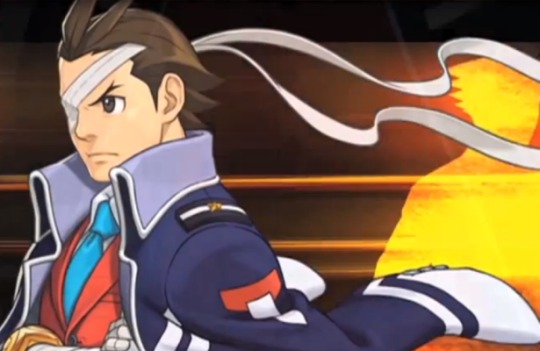
Our first defendant is Juniper Woods, who seems rather sickly and is shown to use sunflowers in her hat as an inhaler within the first few seconds of being on-screen. The narration introduces her as a childhood friend of Athena, and lists that she's the alleged bomber of the courthouse.
Apollo collapses with blood seeping from his bandages (though the blood is never shown on the model), and Athena, who is supposed to be his assistant for the trial, is forced to show up as the acting attorney in his place, making it her first solo trial, and second case as the lead attorney. Here we're shown a quirk of hers for the first time; that is, random exclamations in various European languages.
Predictably, her first case opponent is a Payne, and his arrogance leads her to get mad and for her electronic device, Widget, to reveal another character quirk; that is, it will occasionally say what she's thinking, even if she didn't want it to. The game uses her reflexive denial of this to casually bring up Contradictions, so that you start thinking about them, even if you haven't played Phoenix Wright before, which is nice.
We get a more standard, forced tutorial of evidence and the buttons, but it's the first case, so this always happens. It isn't particularly intrusive as it's just a few dialogue boxes, and it only breaks up the flow of the game by a couple seconds. We're also treated to a sight of Athena being unable to speak due to courtroom-based trauma in her past, before Phoenix Wright shows up to save the day.
Despite the transition to 3D, all of phoenix's reactions are intact. His body language is pretty much identical to that of the original trilogy. At this point phoenix says hello to the Payne brother thinking him to be Winston with yet another toupee, but he is corrected for not using “how do you do” instead of “It's been a long time”. The meaning here is a bit lost, but it's more obvious if you know Japanese; where the greeting for someone you've never met is “Hajimemashite” which literally means it's the first time you've met. This is one of the few times I can say the translation was a little iffy in pulling it off.
Gaston Payne introduces himself as the younger brother of Winston Payne, who he claims is phoenix's “Longstanding Rival” - eliciting a shocked reaction... that turns out to be less about him being the younger brother and more about at what point Winston Payne was considered his 'longstanding rival', or really even his rival at all, showing how different the two parties feel about each other.
The rest of the first case is rife with tutorial, to make sure you know what's going on, but they generally do what they can to reduce it – the tutorial for Cross-Examination, a series staple, is entirely skippable, allowing you to move right past it if you've played the game before, though the tutorial for the new mechanic, Athena's Mood Matrix, is not, and takes a few minutes.
Unusually, the first case takes a break for the day partway in, instead of the more common recess that not even all first cases have, but it does not go into the investigation phase between days, holding the PW standard of leaving the phase out of the first cases.
Similarly, the second trial (though the murderer is revealed by the cutscene at the opening), unusually makes it fairly clear to the characters in-universe who the killer is in the middle of the second day of investigation, and the entire trial from that point onward is about them trying to drag him to the stand and get him to show his true colors, so to speak.

By the end of the second trial you have been introduced to Logic Scenes, which rather than working like Edgeworth’s Logic Chess from AAI2, are small cutscene-like decision lines that build up to the ultimate deciding factor that proves the case with the final piece of evidence; a grand concept that, however, feels slightly lacking in execution – not to say that it is bad, but that it does not stand out as amazingly as it wishes to.
The Mood Matrix also introduces a new mechanic in the second case, which features again in the third – out of control emotions. While it can sometimes be very difficult to do more than guess wildly, it is almost fitting, as the music that plays behind it compliments the scene and emotional lack of control very well.
One thing that returns from other games starting in the second case is that post-trial you will occasionally present one final piece of evidence to the defendant or one of phoenix's partners. In order to leave you unspoiled on what exactly it is, I won't say that, but I'll mention that it (and the cutscene that results from it) gave me a pretty big smile in comparison to several of the other more lackluster implementations in several of the other games.
This game ties a lot into Apollo Justice, and a lot of people think it does so in ways that aren't particularly good for the setup that the previous game had built up, but due to my unfamiliarity with it, I cannot comment too much on this – as someone who has only read about it, however, I felt that it was handled fairly well.
But, more than just the connections to Apollo justice, the cases themselves are interconnected in an even larger way than in previous titles. The first, fourth, and fifth case, are all pretty much one larger case, and take place within the span of about three days, bringing back memories of Ace Attorney Investigations, where Edgeworth's entire game is all centered around a single mystery and all happen under a week from the beginning of the game, to the point that he has almost no time to even *sleep* between them. The final case itself is similarly grandiose, and definitely a worthy conclusion to the game, but it does face pretty stiff competition as far as final cases go, so I wouldn't call it the most prominent in the series.
Edgeworth himself returns to prosecuting the case for a while, despite his role as Chief Prosecutor meaning that he almost never will take the active role as a prosecutor in court again (something which is no doubt disappointing to most AA fans).
That said, as the entire three-part case is part of a seven-year scheme by Edgeworth using his new position to catch a certain criminal, you can really see that he's stepped up from more minor incidents in this game, which is very good for showing why he's not taking all of the spotlight anymore, especially since Phoenix even now just tends to wind up defending literally anyone who he sees and trusts. From the few moments he is in trial, however, we get to see that basically all of his usual poses in court have been transferred over to 3D just as well as Phoenix's, from the dark bags under his eyes when shocked to his tsking motions.
The music in this game is worth examining as well – and while most of the time I would say it's largely forgettable, there are multiple standout pieces as well. Though it plays only once in the game, Edgeworth's theme has been lovingly updated with a full orchestral arrangement, and both the main villain of the game and the theme for the dark age of the law are perfect for the situations they play in. On the same subject, a lot of the old tracks were reprised in this game having received new life, and are generally the better for it.
It's worth noting certain standout side character tracks as well, such as the theme of Yuri Cosmos, who fashions himself the commander of a space battleship and has a theme to match, though the way he does so is more a parody of the kind to come out of Japan's scifi than it is easily recognizable to those only familiar with western works like Star Wars.
With all that noted, it's time for the review categories.
First up Quality Control. While the game has no real bugs (nor should any VN-style game, to be honest), I did notice an amount of spelling errors as I was reading it, which while not hugely immersion-breaking or anything, is not something I remember any of the previous games to have done, so it feels odd watching them take a step backward in this regard.
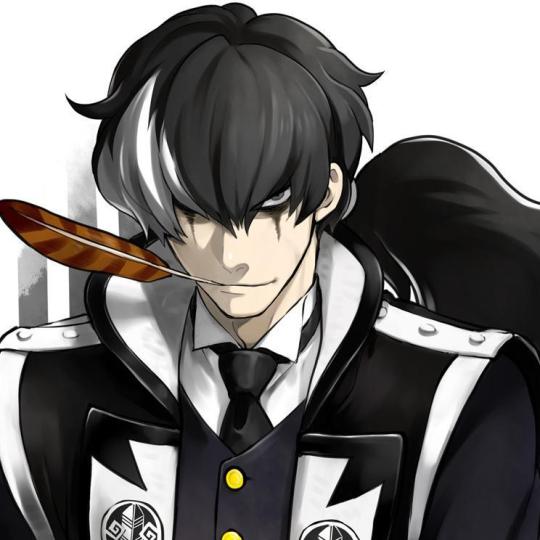
There is also my biggest complaint – though it may sound like nitpicking, reading up on the issue only made me feel stronger about it. To summarize it, Prosecutor Blackquill, the new prosecutor for this game, was originally supposed to carry a katana. However, since swords are not allowed to be carried by civilians in Japan, let alone convicted criminals, they ended up deciding it was “too unrealistic” and struck the katana from his design (but not the slashing and katana references from his poses). This would have been okay, as Phoenix Wright has no small degree of supernatural things going on in the background, and it is pretty anime-genre, in which such a thing is not exactly unheard of, except for the 'small' fact that it was done so late in development that they apparently decided to not change the script *at all*, leaving in such great lines as the judge referring to him having “Fine Japanese Steel”, and the like, despite him visibly not having a sword. This speaks to a level of laziness that is just frankly disappointing from people working on such a series, and I just can't approve of it.
Even though some people might consider this not to be quality control perhaps, this is where I will address that DLC for this game exists. Though it is generally done well – a bonus case that isn't hugely plot-related but shows when the rest of the Wright Anything Agency met up with Pearl Fey, and bonus costumes, it does exist where the other games had none, and that is something that some people may consider a detractor in terms of quality.
Next is a big question: “Was it worth my time?” Without a doubt, I'd say “Hell yes.” Though this is my opinion alone, the third case became my second-favorite case in the Phoenix side of the series, following behind the final case of Justice for All, and probably in the top five if we were to include the two Investigations games.
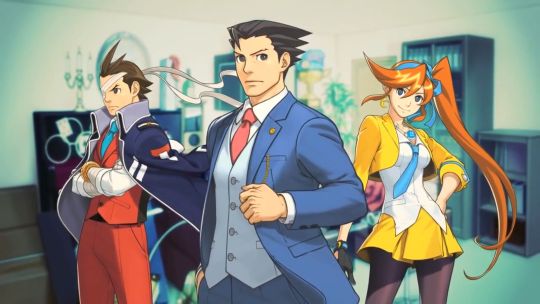
Though Athena doesn't quite live up to Phoenix or Apollo, she's far from a terrible character in my opinion, and it's good to see a girl taking up a lead defense role now and again in the games, even if she's the least experienced of the trio. Prosecutor Blackquill is pretty hilarious even when he's not particularly trying to be, as well, because his entire character archetype is so very Japanese that when relocated into the setting of “America” that the translations use, it makes him look like a giant weeaboo even in serious moments – something encouraged by the reactions of other characters on occasion.
Last but not least is the most important question: “Is it worth your time?” I rather thoroughly enjoyed the game, and I'd say you likely will too, if you give it a chance with an open mind – but, if your favorite game is Apollo Justice, you may find yourself with more problems with the narrative than I had, and this could distinctly interfere with your enjoyment of the game.
For people who haven't played the Phoenix Wright series, I would not suggest this as the place to start, as there are far better games to start with, especially if you have the time to play through all of them from the beginning, but it also isn't horrible for it – I would however suggest starting at the very first game, at Apollo Justice, or at the successor, Spirit of Justice, instead.
On that note, I'd like to cover Spirit of Justice sometime soon, as I received it shortly before I picked up Dual Destinies, and found myself halfway through the game (up to the case with Blackquill's return in it) before I decided I had missed too much and picked up this one to play (and review) first. Because of this, I specifically had to withhold some comments about comparing things that exist in Dual Destinies to their updated versions in Spirit of Justice, but I'll be covering those improvements when I get to that review.
Look forward to it!
– Shameimaru, signing off.
#AKRGaming#AkashicRecordsGaming#Phoenix Wright#Dual Destinies#Apollo Justice#athena cykes#simon blackquill#news#game journalism#game reviews#shameimaru
0 notes
Text
The other half
I’m the other half of AKR Gaming, Yatagarasu. Unlike Shameimaru, I’m not big on the 2hu, so in this case, I took my handle from Ace Attorney instead: the Yatagarasu who steals the truth and brings it to light.
Well, if you know anything about games journalism, you’ll know that official sources, especially ones that provide pre-release coverage, have to tread pretty carefully. For example, Jeff Gerstman was infamously fired by GameSpot for panning a crap game that was heavily advertised on the site before its release. Electronic Gaming Monthly has been threatened by Acclaim and CAPCOM and had games denied to it for review because of fears of bad press (in other words, acknowledging that a game is so bad they can’t afford to let an honest outlet review it). Back in the days before Assassin’s Creed II, Ubisoft kicked up a shitstorm by refusing to allow reviewers to touch pre-release copies unless they agreed in advance to give a positive review. Team17 infamously had a feud with Amiga Power over poor reviews of some of their titles, including trying to hit them for libel with regards to a particularly trashy game (seriously, just google it).
The advantage to being nobody and not relying on advertising for revenue is that it opens the avenue of being brutally honest in a review. I’m a bit more judgmental than Shameimaru, and I don’t have a lot of patience for fake difficulty and busted controls. On top of that, I live in Australia, which means that for older games, I’m playing a different version to Shameimaru, while I might be waiting a long time for modern games even in this era of digital distribution - for example, we have to wait until the end of the year for SMT4A, and had to wait 18 months for SMT4.
When I rate a game, I’ll rate it on the following categories, each scored out of five:
Technical: Lack of bugs and/or glitches related to the game itself, and ease of use of control scheme (including editing it). A game that works fine and either has a functional default control scheme or can be easily edited to be functional willl get a 5 in this category. A game that is a buggy, glitch-ridden mess will get a 1. A 4 probably indicates that the game’s glitches are unobtrusive, don’t impact unduly on gameplay, or are funny rather than harmful, while 2 and 3 indicate impact on gameplay. Lag issues on console will also get a game docked here, as will poor optimization of PC games (including a lack of ability to manipulate graphics settings).
Gameplay: This is the yin to Technical’s yang - gameplay is rated on how solid the foundational mechanics of the game are, how well they play out in practice, how arcane they are, and how rewarding mastery is. In the case of visual novels, this score is more based on the interaction of the player with the narrative: highly-branching games will score higher here, as will games like Ace Attorney. A 1 for a VN is for games like Umineko no Naku no Koro ni or Muv-Luv Alternative.
Audio-Visual: Some games aim to really impress with their looks and soundtrack, and that’s what this category is all about. Generally speaking, I’ll be basing this on the graphics and background music rather than sound effects, although if there’s voice acting I’ll take it into consideration (generally lesser than other things, though, as voice direction in games is infamously poor to begin with). For VNs, this is more based on how well the soundtrack, SFX, and graphics are used to expand on the reading of the narrative.
Narrative: If a game has a narrative at its forefront, then this category grades it based on how well it tells the narrative and how good the narrative is to begin with. Obviously this is subjective and hard to discuss without spoilers, as well as being a category that doesn’t really apply to a lot of games (particularly older games where the plot could often be crystallized into “are you a bad enough dude to rescue the president”), so this is one of two categories you should definitely feel free to ignore.
Fun: The most important category, this is basically how much fun I had playing the game. It also covers aspects like replayability (where appropriate), and I’ll talk about the difficulty curve and issues with fake difficulty and padding here. Like narrative, because fun is subjective, you can ignore this category too, but in general, my opinion of a game will be much higher if it rates a 5 in this category and a 1 in every other category, than if it rated a 1 in this category and a 5 in every other category.
Overall: I don’t actually provide an overall score. You can add it up yourself if you want (it’ll come out to /25 for games where the narrative matters and /20 where it doesn’t), but I think giving an overall score can often be misleading about the quality of a game. The point of having separate categories to begin with is so that you can decide for yourself which parts of a game are most important to you.
There’s also the perfect problem to discuss, which is basically to say: what do you do when you rate a game perfectly in a category and then a game comes out that eclipses it? Amiga Computing just gave the better game 109% instead of 100% since it was apparently 9% better than a previous game rated at 100%. In this case, it’s also worth remembering that the landscape changes between games: I might have rated a game highly for doing something fairly innovative, and a game that came out later that is said to be better might get hit with a lower score despite incorporation of aspects from that game because they’re cookie-cutting rather than coming up with something new. That said, this is also part of the reason I chose to categorize things as I did; the ratings here aren’t exactly relative to other games. On top of that, I’m not exactly going to dock a PSX game for not measuring up to the graphics of PS4 games.
If you want to get in contact with me directly, you can either message me through tumblr (akashic-yatagarasu) or use my business address, [email protected] . You can also check me out on twitter at @Animelysis along with my anime essays blog, http://animelysis.wordpress.com, which is currently sitting unupdated as I haven’t found anything worth essaying about for a while. If you want to see me losing at games, you can check out http://twitch.tv/RayOfSpeed.
-Yatagarasu
0 notes
Text
Shameimaru’s Grand Debut
Aah, I really did it. My nerves are getting to me. AKR Gaming is finally up, and with it, my career begins. I’m already halfway through my first review - Ace Attorney: Dual Destinies - and have a partner I can trust to help out with it. Our writing styles are a bit different, but I hope together we can have a lot more fun with this than trying to go it alone.
This really doesn’t quite feel real, though. It was kind of an impulse, but it’s already leading me toward something I great in the future. So this is what it feels like to start taking your first steps somewhere.
I think I could get used to this.
0 notes
Text
AKR Gaming’s Grand Opening
I’ll be the first to say it. I’m not exactly a journalist, so I always shied away from this idea. I’m also a notable procrastinator, so I ended up putting this off longer than I wanted, as well. But I love games, and I love writing, and I’m sick of only spinning my wheels.
And so, I’d like to announce this as the day I finally began the first steps toward a goal. I’m opening AKR Gaming, my own blog for gaming journalism. I’m new to this, so bear with me, I’ll definitely be taking a while finding my feet, especially on my rather limited budget. But with my birthday coming up, I’m likely to get at least some things to comment on as they come out.
So I’d like to first cover a release schedule. While it won’t be quite so regular, since I’m still having to learn exactly what I should be doing, I plan to try and do two game reviews a week; one that is a more recent release, and one that is an older game. It will likely take longer and be less regular at first, as I said, but once I’ve put out a few and know the time and effort I need to do for each of them, I’d like to set specific days of the week that anyone who follows can know to expect new content on.
Last but not least, to add a personal sense, I’d like to introduce myself. As those of you who are familiar with my blog icon might expect, I’m your host, Shameimaru. I’d like to avoid the name “Aya”, as rather than calling myself the character, I’d just like to use her last name as a stage name for this debut. She’s the ‘person’ who first got me into the concept of journalism, so in this way I’m honoring my influence and hoping to at least live up to a legacy of fast news - though hopefully more reputable.
On that note, reputable game journalism was the real spark here. So many people complained when scandals involving games journalism appeared, and yet so few people did anything personally. Though it’s been a long time since those events have happened, perhaps it’s settled down enough for me to find a less rocky start for the future. And with that, my introduction is over. I do have a bit of a tendency to ramble - you’ll notice I thought the last paragraph would be a paragraph ago.
New content coming soon, hopefully!
- Shameimaru, signing off.
0 notes